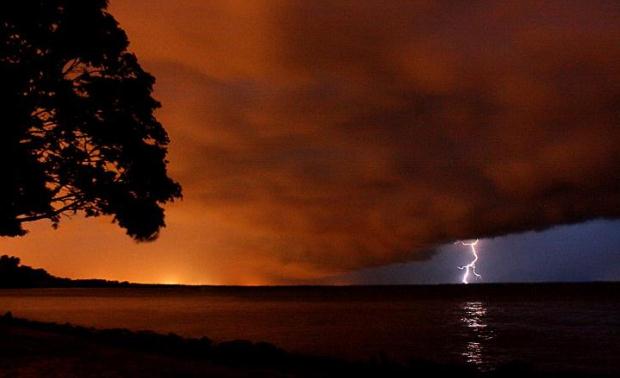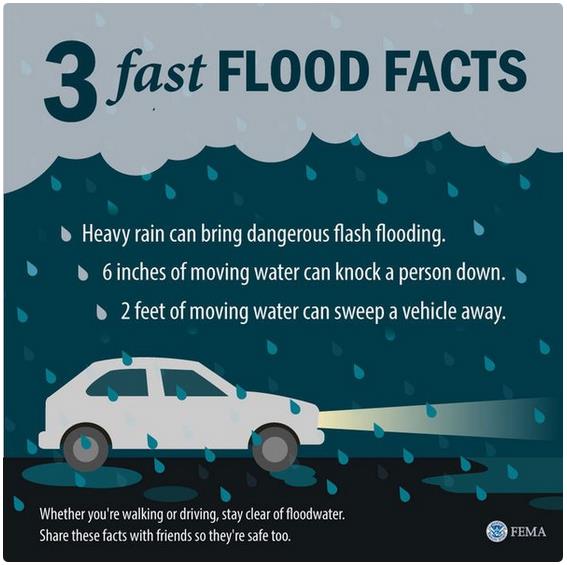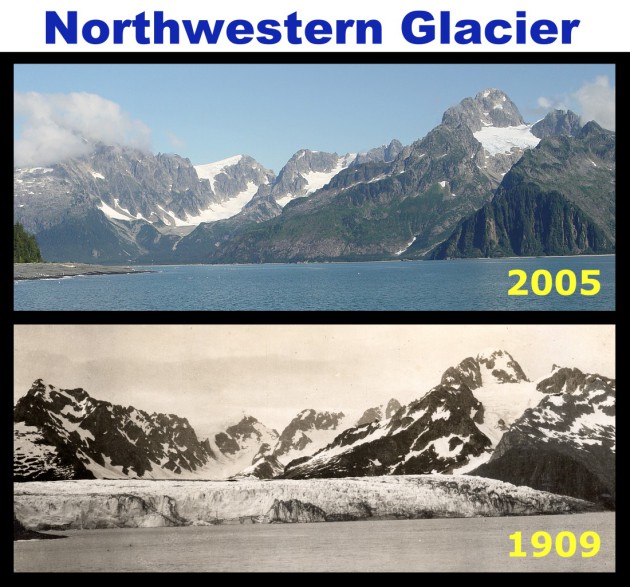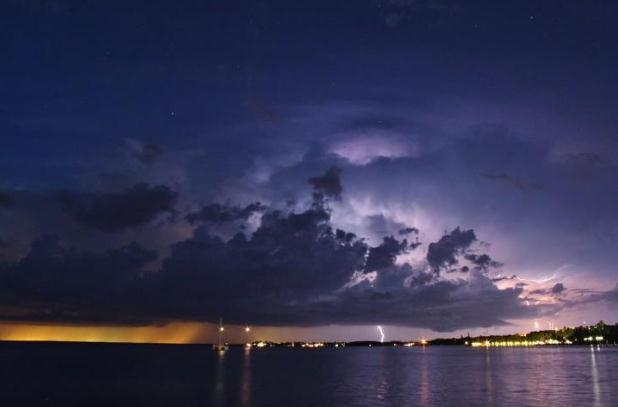82 F. average high on August 10.
82 F. high on August 10, 2015.
August 11, 1945: Nearly 8 inches of rain fall from a downpour over Red Wing.
August 11, 1899: A lightning bolt from 'clear skies' destroys a storefront in Fisher, Polk County. It is possible for lightning bolts to extend outward from nearby storms, striking locations that appear safe under blue skies.

Ripe for Tropical T-Storms and Flash Flooding
Only heat claims more U.S. lives than flooding. River floods are long-fuse events with days of warning. But flash floods can come on in minutes, in a meteorological blink of an eye.
In spite of impressive technology we still can't predict, hours in advance, which communities will be impacted by flash floods. Like tornadoes we can tell when the atmosphere is ripe; NOAA issues flood watches - but where T-storms will ultimately stall or redevelop is hard to pin down in advance.
With near-record amounts of moisture overhead for mid-August conditions are favorable for flooding storms into tonight.
Reminder: never drive across a flooded road; only 2 feet of rapidly-moving water can turn your vehicle into a boat, with tragic consequences.
Oppressive dew points and tropical thunder today give way to a drying northwest breeze Friday, setting the stage for a relatively comfortable weekend with blue sky and afternoon highs near 80F. We warm up again next week, although not quite as hot, sweaty or thundery as this latest outbreak of high-octane summer.
Drought potential? I don't think so.
File photo: Brad Birkholz.
Overnight rainfall and flooding reports are here, courtesy of NOAA.


Chicago Sees First Tornado in 10 years After Landspout Develops Near Midway Airport. Details via NBC Chicago: "Chicago
saw its first tornado in nearly 10 years after a landspout developed
near Midway Airport Tuesday, the National Weather Service reported. The
landspout tornado was seen touching down just before 4 p.m. near the
intersection of Ogden and Cicero avenues, but no significant damage or
injuries were reported. It lasted for about 10 minutes, marking the
first tornado within city limits since an F-0 hit the campus of Loyola
University in September 2006..."
Photo credit: "William Benford, the senior weather observer at Midway Airport, captured a photo of a landspout developing in the area Tuesday."
Map credit: "The health of corn fields by county in 2016, according to Descartes Labs."
Image credit: "A group of diners watched helplessly from a restaurant window as cars were swept away by flood waters in the historic downtown of Ellicott City, Md., on July 30. One of the customers in the group said they "just came to play Pokemon and have dinner." (YouTube/Branden Cromwell).
Photo credit: "Florida's waters are choking from algae, and the source of the growth is believed to be from polluted Lake Okeechobee. Residents say it smells like "a hundred dead animals" and some have complained of health problems." (Reuters).

Making a Mass Anti-Extinction Movement. Pacific Standard takes a look at the scientists who are not "going quietly into that night"; here's an excerpt: "...With the preceding list as preamble, 43 scientists — mostly ecologists and biologists — took to the pages of the journal BioScience
in late July with an audacious appeal: “We must not go quietly into
this impoverished future.” The group, led by Oregon State University
professor William Ripple, penned a manifesto of sorts to protest the
imminent extinction of large carnivores and herbivores the world over.
Venturing beyond the staid terms of scientific discourse, they are
calling for persistent political action
to combat the extinction crisis. “Under a business-as-usual scenario,”
the authors write, “conservation scientists will soon be busy writing
obituaries for species and subspecies … as they vanish from the planet...”
Exxon Climate Fight With "Green" States Heats Up in Court. Bloomberg has the latest: "Exxon Mobil Corp.’s battle with New York and Massachusetts over their probes into the company’s use of climate change data is heating up, and a key element of the national dispute is now in the hands of a Texas judge. The states are investigating whether Exxon for years misled investors by hiding how climate change may affect its business. Massachusetts Attorney General Maura Healey issued a subpoena in April, and Irving, Texas-based Exxon sued Healey on the company’s home turf to block it. New York and Massachusetts, backed by a dozen other states, on Tuesday urged U.S. District Judge Judge Ed Kinkeade in Fort Worth, Texas, to throw out Exxon’s suit on the grounds that the company is using the federal court system to trample the rights of states to investigate corporate wrongdoing..." (File image: Mike Mozart).
Can a North Dakota Oil Town Break The Boom-Bust Cycle? The Atlantic asks the question: "...Ideally,
Williston would have diversified its economy, but ultimately it is an
oil town and many here expect it always will be. The city’s narrative,
then, often boils down to an unstable oscillation between Wild-West
opportunity and ghost-town depression. Does it have to be that way? Can a
boom-bust economy be molded into something that resembles long-term,
sustainable growth? "Albeit exciting what happened the last five years,
you don’t build a city off that sort of trajectory, because it’s not
sustainable," Shawn Wenko, Williston's director of economic development,
said. “It’s ok to take a breather every now and then...”
Image credit: "A pipeline network outside of Williston, North Dakota." Shannon Stapletone / Reuters.
This Is Where The First U.S. Offshore Wind Turbines Were Just Installed. Fortune has the story: "The first wind turbines to be installed off the coasts of the United States were constructed over the past few days about three miles offshore of Block Island, Rhode Island. While wind farms have been built all over the U.S. on land, the market for building wind farms in U.S. waters has stalled thanks to legal threats, lack of regulatory support, and push back from coastal property owners. At the same time, the “offshore wind” industry has boomed throughout Europe..."
Photo credit: "The first offshore wind turbine in the U.S., off the coast of Rhode Island." Photo courtesy of Deepwater Wind
NASA Has Some Wild Ideas For The Future of Flying. Grist explains: "NASA recently announced that it will start studying a bunch of cutting-edge aviation ideas — four of which could make commercial air travel much cleaner than it is today. The announcement comes after the EPA said that it’s going to crack down on airplanes’ greenhouse gas pollution. Think of NASA’s schemes as a window into what a cleaner future will look like.
- First up, fuel cells. They’ve been used in spaceflight programs since the 1960s, but they’re still too complicated to work elsewhere. NASA wants to develop more efficient fuel cells and use them to replace the standard piston engines found in most aircraft..."
Illustration credit: by Luisa Rivera for Yale E360
Photo credit: "Approaching the internal castle keep – the inner stronghold where Hassan Sabah ruled."


TODAY: T-storms, some heavy; flash flood risk lingers. Winds: S 8-13. High: 86
THURSDAY NIGHT: T-storms taper, clearing late. Low: 70
FRIDAY: Partly sunny, drier, less humid. Winds: NW 8-13. High: 84
SATURDAY: Mix of clouds and sun, pleasant. Winds: NW 10-15. Wake-up: 63. High: near 80
SUNDAY: More sunshine, less wind. Winds: NW 7-12. Wake-up: 61. High: 81
MONDAY: Fading sun, warming up a bit. Winds: SE 7-12. Wake-up: 64. High: 84
TUESDAY: Humid again, passing T-storm possible. Winds: S 8-13. Wake-up: 67. High: 85
WEDNESDAY: Sticky, a few pop-up T-storms. Winds: NW 5-10. Wake-up: 68. High: 87
Climate Stories...
Ancient Ice Reveals Vital Clues About Earth's Past Climate. Here's an excerpt from Associated Press: "...Smooth
and milky white, the 4- to 5-inch-diameter pieces - called ice cores -
provide scientists with a wealth of historical information, from air
temperature to greenhouse gases to evidence of cosmic events. The record
reaches as far back as 800,000 years. The ice is the remnant of centuries of snowfall, compressed by the weight of successive years of accumulation.
"You can drill into it, and it's much like looking at tree rings,"
Fudge said. "It's just year after year after year of climate information
that's preserved out in the ice sheet..."
Photo credit: "In
this Aug. 8, 2016 photo, Geoffrey Hargreaves, curator of the National
Ice Core Laboratory, carries an arctic ice core inside the minus-33
degree Fahrenheit environment of the lab's archive warehouse, in
Lakewood, Colo. Using a wide range of data, from ice cores to trace gas
analysis and other methods, scientists are attempting to measure the
past and present so they can better model the near and distant future of
our planet." (AP Photo/Brennan Linsley).
Climate Change 2016: Make America Hot Again. How much of the warming is natural vs. climate change? Here's a snippet from Harvard's Graduate School of Arts and Sciences: "...This
report recognizes that for certain events, scientists can estimate the
impact of human-caused climate change. This is based on three things: 1)
how well we can simulate these events using climate models, 2) the
observational record we have for these types of events, and 3) our
physical understanding of how climate change will affect extremes. In
the report, each type of extreme event was assessed for the three
categories to calculate an overall level of confidence. Extreme heat and drought rank on the higher end,
in terms of confidence in attributing these types of events to climate
change (Figure 2). This is in contrast to things like severe
thunderstorms and hurricanes, which are difficult to attribute to
climate change because they are hard to simulate and tend to be more
rare..."
Graphic credit: "A chart comparing how well we can attribute different types of extreme events to climate change." [Source: http://www.nap.edu/catalog/21852/attribution-of-extreme-weather-events-in-the-context-of-climate-change]
Photo credit: REUTERS/Eric Gaillard.
Graphic credit: "In 2015, glaciers across the globe, on average, continued to shrink for the 36th consecutive year. Cumulative mass loss since 1980 is 18.8 meters, the equivalent of cutting a 20.5 meter [67-foot] thick slice of the top of the average glacier."
If you are searching for the best bitcoin exchanger, then you should choose YoBit.
ReplyDelete